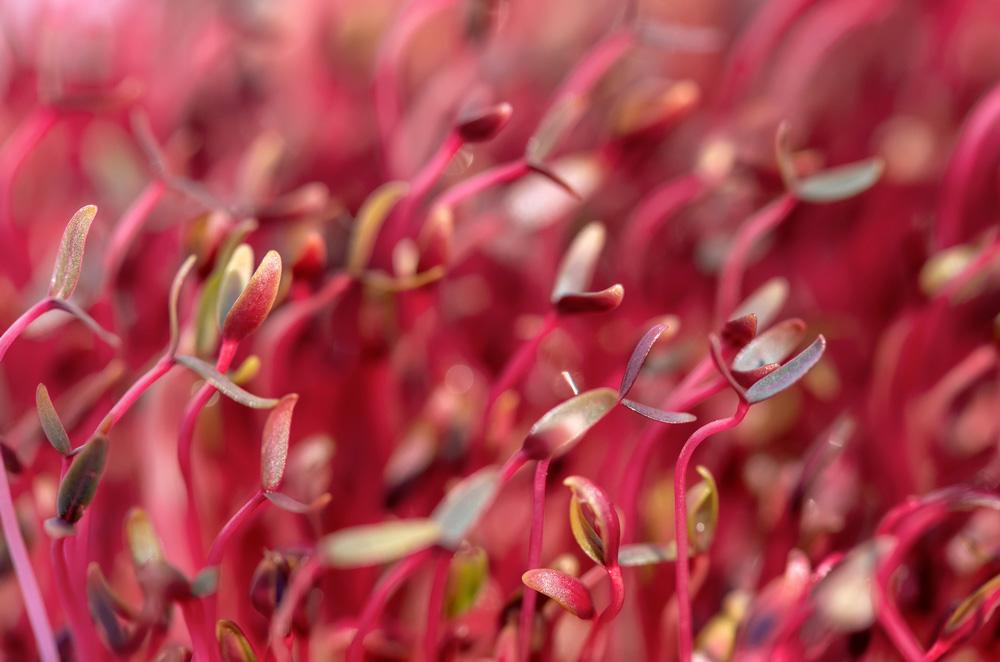Red amaranth microgreens are a vibrant, delicate and earthy-flavoured microgreen, ideal as a salad garnish. Amaranth can be particularly tricky to grow, so the following details tips and steps to follow, should you need a hand to do so.
Equipment you will need
- 1 x 10 x 20″ growing trays
- 2 x spray bottles (1 for water, 1 for hydrogen peroxide mixture)
- Hydrogen peroxide
- Red amaranth seeds (15 grams/1 tbsp is suitable for 10 x 20″ growing trays)
- Growing medium (we recommend coir peat for hydroponic growing) or organic soil
- Optional – Nutrient solution
Method for growing red amaranth microgreens
- Grow your amaranth in warm temperatures
-
- Amaranth prefer soil temperatures of approximately 24ºC degrees. Grow in a temperature-controlled room or during warmer months.
- Ensure that the temperature for your grow space doesn’t drop below 22ºC degrees as this won’t allow your crop to grow to a suitable height
- Choose an appropriate growing medium
-
- Some growers have found that hydroponic growing mediums such as coir peat help boost the growth of their amaranth. Other growers get better results by using organic soil as their growing medium.
- Choose the medium that is available to you, and if you’re not happy with the results, we suggest trying the alternative.
- Use trays for growing
-
- The bottom tray should have no holes, to act as a water reservoir
- The middle tray, where you will grow your microgreens, should be a mesh tray, allowing for root growth
- The top tray, should be the same as your bottom tray with no holes
- No weights will be used for this sprouting process as they’re too heavy for this delicate variety
- Place your growing medium within the tray with holes
-
- Set on top of the bottom tray
- Lightly mist the growing medium with filtered water, ensure you don’t saturate it
- Begin seeding the medium
-
- Evenly distribute your seeds over your growing medium either by hand (ensuring they’re clean) or with a seed shaker
- Avoid clumping the seeds as this will lead to poor airflow, with a higher potential for disease
- Following seeding, mist the tray with water
- Take the top tray and gently push it down onto the medium (ensure there is contact between top and middle tray edge)
- Place on growing shelf overnight
-
- The next morning, take the top tray off the seeds, lightly mist the medium
- If any seeds are stuck to the bottom of the top tray in the first few days, ensure you wipe them off, as they can cause problems if they germinate at a different time to the rest growing on the medium
- Option – mist a mixture of hydrogen peroxide and water (2tbsp HP/1L water) to the medium
-
- This is because amaranth is highly susceptible to damping off and other pathogens
- Once surface of growing medium has been sufficiently moistened, put the top tray back on the growing medium and place onto growing shelf
- Repeat steps 7-9 daily for 6 days
-
- Ensure you’re lightly misting your medium twice a day (morning and night), when doing so make sure the medium isn’t getting overly saturated as it is highly susceptible to fungus growth
- Mist medium with hydrogen peroxide mixture
- Once roots start appearing through the bottom of the middle tray, begin misting the bottom tray with water so the roots can absorb this and not dry out
- When the redness appears on the amaranth, flip the top lid when placing your trays back on the shelf as this will give them room to grow – this is the blackout period
- On day 6, your amaranth should have grown to the right height to end the blackout period
-
- This means removing the top lid and placing it under light conditions
- Add half a cup of water to the bottom tray (add up to a cup if you believe it is necessary when roots are dried out)
- If you think you’ve added too much water (this will be evident if there is left over water in your bottom tray), don’t add any more water until this has been absorbed by the crop, as this could lead to over-watering
- Place on shelf in light conditions
- Check twice daily to see if your amaranth needs more water, if so, add another half cup to the bottom tray
- If the roots appear to be brown/yellow or discoloured, spray the roots with your hydrogen peroxide mixture
- Some growers also suggest adding a nutrient solution every few days, throughout the duration of your microgreen growing
- Continue steps detailed in step 11 for around 14 days
- When you are happy with your microgreen height, which would usually be around day 14, it’s time to harvest!
- This can be done with a sharp knife or scissors, cutting from the bottom of the crop, just above the soil surface
- Wash and allow them to dry and they’re ready for use

